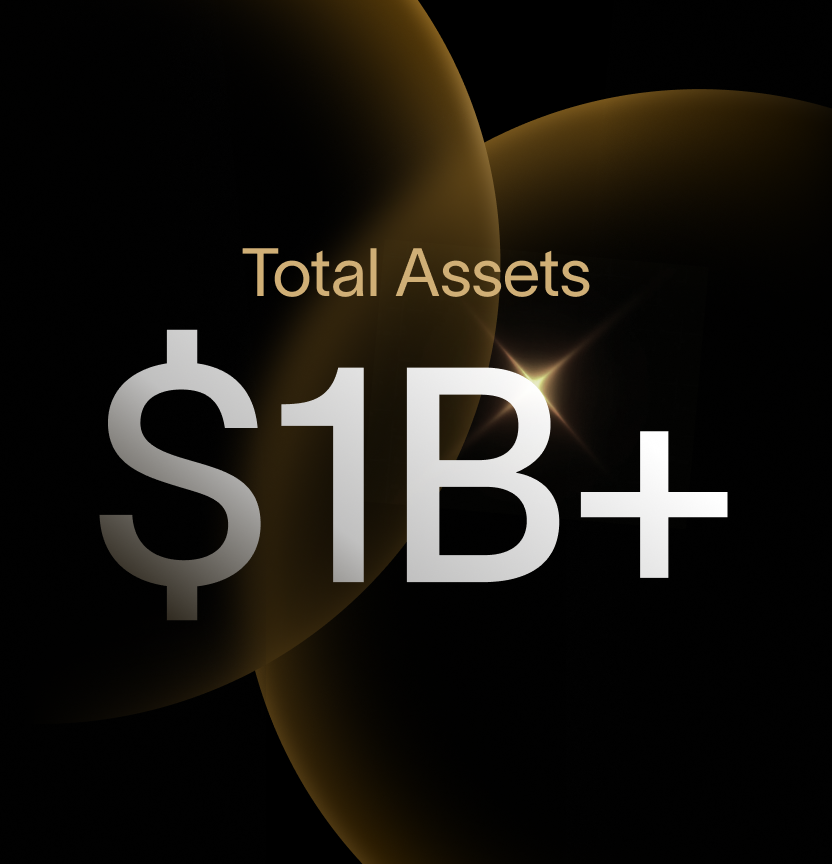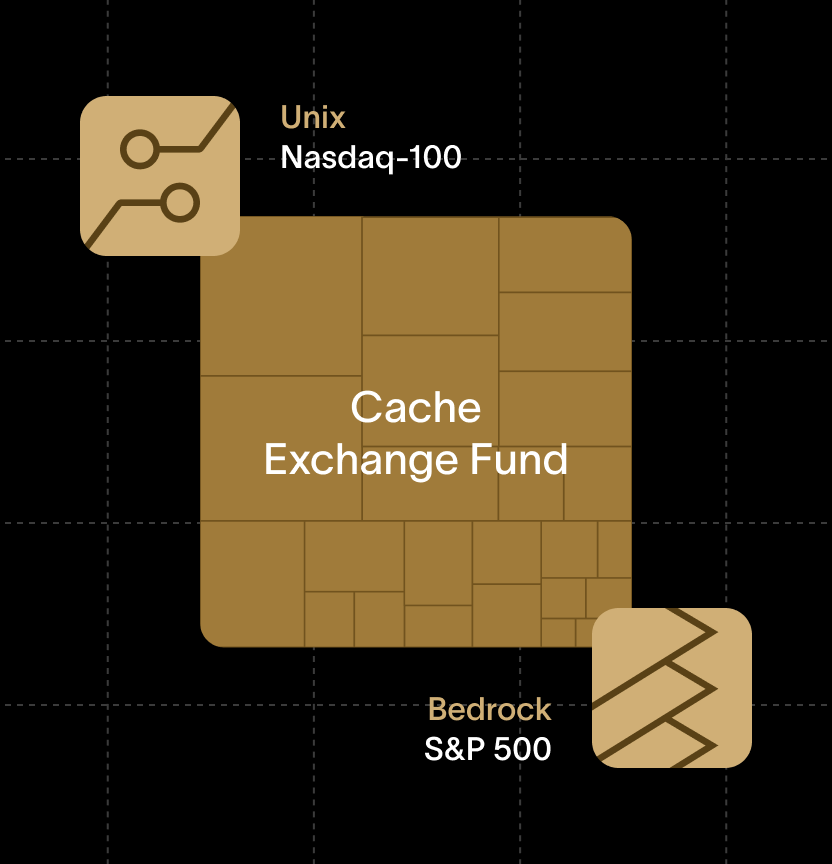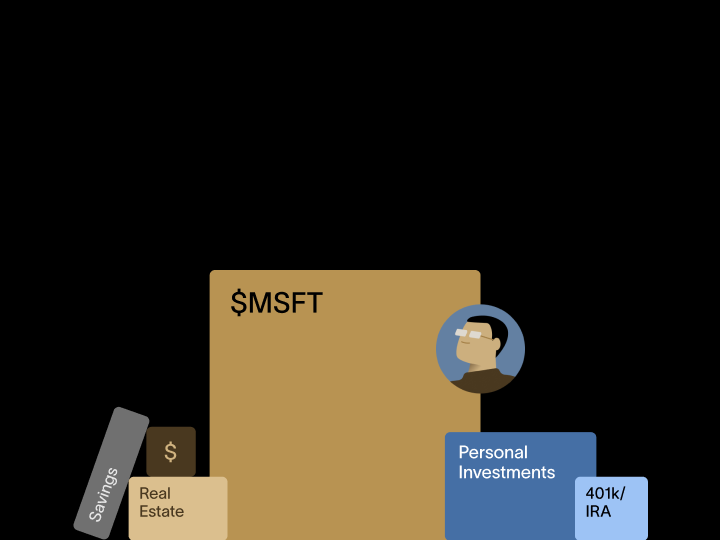How do exchange funds work? The ultimate guide
If you hold a large stock position and have a long-term investment horizon, exchange funds can be a tax-efficient way to diversify your portfolio. These funds let you pool your stock with investors who hold concentrated positions in other stocks, creating a pooled fund. By exchanging your stock for shares in the fund – instead of selling and diversifying on your own – you and the other investors get to diversify your portfolios and defer capital gains taxes at the same time.
Because it can reduce your risk and the tax drag you’d experience by selling stock, an exchange fund can do a lot to help you achieve your long-term investment goals. But how does an exchange fund work, and what will it mean for your overall investment picture? This article will make all the little details easy to understand.
If you’d like a higher-level overview, you might want to start with our introduction of what an exchange fund is.
The underlying issue many investors face
When you hold a stock position that has appreciated significantly, the prudent decision is often to take risk off the table. Generally, most financial planning literature suggests limiting your exposure to any single stock to less than 10% of your net worth.
To reduce this concentration risk, the prevailing advice you’re likely to hear is, “You should sell and diversify.” And that’s what most investors typically do: Sell their concentrated position, pay the capital gains tax, and diversify into a diversified investment such as an index fund. As you can imagine, selling appreciated stock can lead to a huge tax bill that can negate years of growth in your portfolio in the form of tax drag. Understandably, some investors choose the risk of a concentrated position over suffering this tax drag on their portfolio. Taxes are one of the most common reasons people hold on to concentrated stock positions.
Managing a concentrated stock position can feel like a no-win situation – you either hold on to too much risk or incur a huge tax bill.
Enter the exchange fund
Exchange funds are a type of private fund that can give you tax-efficient diversification by delaying the “sell” part of the sell-and-diversify strategy. To achieve this goal, an exchange fund pools together stocks from multiple shareholders in specific amounts to target a particular mix – like a stock market index.
Since you exchange your stock for fund shares, you (and all the other investors) are diversified by virtue of participation.
After a seven-year holding period, you can withdraw a diversified basket of stocks from the fund. The current tax code treats contributions to – and redemptions from – qualifying exchange funds as non-taxable. That means you can diversify your concentrated position without suffering tax drag. Instead, your taxes are deferred until you decide to sell the assets you’ve withdrawn from the fund, and the cost basis from your original stock carries over.
So why do people choose the sell-and-diversify method instead of participating in an exchange fund? One of the biggest reasons we've heard is that the majority of investors haven’t had the option of choosing an exchange fund until recently.
{{black-diversify}}
The history of exchange funds
Exchange funds are nothing new. In fact, they have been around in some form since the tax code established Section 351 Exchanges in the 1930s. The tax code also includes provisions for "like-kind" exchanges, and you might have heard of the 1031 Exchange, which was created in 1954 to allow real estate investors to defer taxes when exchanging property.
Who offers exchange funds? Today, exchange funds are offered by prestigious investment firms like Goldman Sachs and Morgan Stanley. Institutionally, they have been available since the 1960s, and they started to become more widespread after Eaton Vance (now part of Morgan Stanley) obtained an IRS ruling in 1975 that clarified the conditions under which they are allowed.
However, they have primarily targeted ultra-wealthy investors through private wealth channels, resulting in limited general awareness. Exchange funds have only received attention when the finances of wealthy public figures are scrutinized, as seen in the New York Times piece about Mitt Romney during the 2012 presidential election. Even today, a Google search for "exchange funds" mostly yields results related to similarly named "exchange-traded funds" (ETFs).
But, things are starting to change. In the past, exchange funds were only accessible to "Qualified Purchasers" with more than $5,000,000 in investment assets. The relatively short list of traditional providers also required a minimum investment of $500,000 to $1 million. In 2023, our company launched the Cache Exchange Fund, which expanded eligibility to accredited investors, with lowered investment minimums and lowered fees, making it available to a much larger population.
What rules apply to exchange funds, and who can participate?
While exchange funds have many benefits, they are a long-term investment, and they are only available to certain investors. These are the basic rules and terms that apply to who can invest, the duration of their participation, and what assets a fund can hold:
Timeline: How an exchange fund works
Unlike an ETF or mutual fund, exchange funds are not ready for investment continuously. They open to contributions at periodic intervals when sufficient diversity of demand exists. Once a fund manager has identified participants with the right mix of stocks to achieve the fund’s objectives, there is an escrow-like period leading up to the fund’s closing. Then the fund is created and its manager administers it for at least seven years when tax-deferred withdrawals become available – and potentially beyond. Here are detailed timelines that show you what you can expect from the process if you indicate interest and participate in an exchange fund.
{{black-diversify}}
How fund participation works
Once the fund is set up, there are a few notable milestones before you can redeem your shares in the fund for a tax-deferred basket of stocks. These are the stages you’ll encounter throughout the lifecycle of your investment:
What makes exchange funds effective for certain investors?
Exchange funds are for sophisticated investors with a concentrated stock position and a long-term time horizon for their investments. If you are all of those things, here are some simple examples of the diversification and tax advantages you might experience.
The benefits of tax deferral:
Exchange funds help defer taxes, but they don’t eliminate them. So is there still a financial benefit if you have to pay taxes eventually? Yes!
When you defer taxes, the money you would have paid in taxes remains invested and working for you in the market. It’s generally a good idea to take every dollar of tax deferral when you have an option because the leverage you gain by deferring taxes results in a compounding effect on returns. A smaller post-tax asset base can’t keep pace over time.
You can see how it works in this example:
If you want to play with the numbers, our exchange fund calculator does a great job explaining the compounding effect of tax deferral in a more interactive way.
The benefit of reducing concentration risk:
It can be a great feeling when you’re sitting on a pile of company stock that is increasing in value every day. However, it's a great feeling that comes with a downside : concentrated risk.
If your company takes a hit, your entire portfolio could suffer. As the legendary investor and philanthropist John Templeton once said, "The four most dangerous words in investing are: 'This time it's different.'" And he's right. It's always risky to put all your eggs in one basket, which is why it’s generally recommended that no one asset should make up more than 10% of your portfolio.
Moving out of a concentrated position may also improve your returns over time. While past performance is no guarantee of future returns, our analysis of the stocks in the Nasdaq-100 index found that almost three-quarters of the stocks in the index underperformed the index over a 22-year span and that 44% of those stocks actually lost money over that time period. On a risk-adjusted basis, very few stocks outperform the Nasdaq consistently. Other researchers have seen similar results when comparing index funds and individual stocks.
Tax planning advantages:
Instead of being forced to liquidate your concentrated position when you still have high income and an unfavorable tax bracket, exchange funds provide diversification today and let you control when you liquidate your stock (if at all). This means you can liquidate small portions of your portfolio when you are in a lower tax bracket, or you can wait until you live somewhere with lower tax rates. By participating in an exchange fund, you don’t have to be concerned with concentration risk while you wait for a better tax window to open up.
Estate planning advantages:
Exchange funds can even provide significant estate planning benefits for certain investors. Upon your death, the current tax code allows your heirs to withdraw the diversified basket from a fund on a stepped-up basis. That means they wouldn’t have to pay any taxes for the appreciation of your stock at all. Of course, they might still be subject to estate taxes if your estate is larger than $13.99 million – the federal estate tax exemption in 2025.
What are the risks of an exchange fund?
Exchange funds can help you in lots of ways, but they’re not for everyone. In addition to the eligibility limitations discussed above, here are three other considerations for investors.
Liquidity considerations
Exchange funds are a long-term investment. Period. To take advantage of the tax benefits of an exchange fund, you are required to hold your shares for at least seven years. They simply do not offer daily liquidity like ETFs or mutual funds.
Tax considerations
There’s a chance that tax laws might change in the future, which may impact the favorable tax treatment of an investment in an Exchange Fund. While the benefits may be grandfathered in any new tax regulations, retroactive treatment is not guaranteed.
Investment considerations
Exchange funds are a passive investment vehicle designed to provide diversified exposure. They do not guarantee higher returns than their underlying stocks, and they are likely to fluctuate with market conditions. While exchange funds may be designed to track an index fund or ETF, it should also be noted that fund managers have limited ability to sell stock positions and rebalance the fund. Diversification reduces concentration risk, but it does not eliminate investment risk completely. It is still possible to lose principal when you participate in an exchange fund.
Examples of typical exchange fund participants
Assuming they are qualified investors and have a long-term investment outlook, these are three examples of the types of investors who may wind up finding an exchange fund useful:
How much should investors like these invest in an exchange fund?
When you contribute to an exchange fund, you don’t have to contribute all of your concentrated position. In fact, it’s quite common to use a variety of tools to diversify. It’s up to you (and any advisors you work with) to decide what your investment goals are and how to reach them. Consider an exchange fund to be one part of your overall strategy, and slot it in accordingly under the long-term investments column. We commonly see investors earmark 20-40% of their portfolios for the long term, but the amount can vary, depending on your financial circumstances.
How do you learn more?
If there’s one thing all the investors in the examples above have in common, it’s that they have a long investment horizon and a large holding in at least one stock. If that also describes you, then you might want to start looking at exchange fund providers or talking to advisors about your options.
Now that you know how an exchange fund works, you should be in a good position to have a productive conversation. We would be more than happy to answer any of your questions – whether they’re about The Cache Exchange Fund or about exchange funds more generally. Feel free to set up a quick call with our team, or take a closer look at our modern exchange fund products.
<div class="blog_disclosures-text">Material presented in this article is gathered from sources that we believe to be reliable. We do not guarantee the accuracy of the information it contains. This article may not be a complete discussion of all material facts, and it is not intended to be the primary basis for your investment decisions. All content is for general informational purposes only and does not take into account your individual circumstances, your financial situation, or your specific needs, nor does it present a personalized recommendation to you. It is not intended to provide legal, accounting, tax or investment advice. Investing involves risk, including the loss of principal.</div>
Detailed Info
Detailed Info
Detailed Info



































.png)







